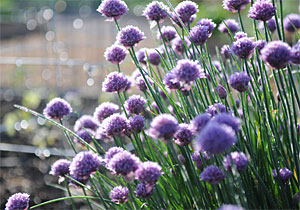





As a founding employee of Gardener's Supply, I wore many different hats over the years. Currently, I have my own company called Johnnie Brook Creative. The gardens around my home in Richmond, VT, include a large vegetable garden, seasonal greenhouse, cutting garden, perennial gardens, rock garden, shade garden, berry plantings, lots of container plants and a meadow garden. There's no place I'd rather be than in the garden.

To add chive blossoms to green salads, remove the central stem and separate the florets.
Nothing says "gourmet" like a sprinkling of colorful flower petals in a salad, a tiny bouquet of Johnny jump-ups on a birthday cake or a sautéed daylily bud in a stir fry. Edible flowers are a fun and easy way to add color and flavor to all sorts of dishes — especially when you can pick them right from your own garden.
Most edible flowers are best eaten raw—simply pick and rinse with water. Flowers will taste and look their best right after they have opened, rather than after they have been open for a few days.
There are only two important things to remember about edible flowers: First is that not every flower is edible. In fact, some flowers can be poisonous. So stick with flowers on the list below, or do sufficient research to ensure your safety. The second caution is to avoid flowers that may have been sprayed with an insecticide, fungicide or herbicide. Because most edible flowers—except for roses—are easy to grow, this is rarely a problem. Be sure to take dandelions off the list unless you have an organic lawn.
For flowers that look good as well as taste good, consider some of the following:
Alliums. Chives, leeks and garlic are all delicious in green salads, potato and pasta salads and dips. Remove the central stem from the flower cluster to release the separate florets.
Nasturtiums. Blossoms have a peppery flavor like watercress. All colors and varieties are tasty in salads or as garnishes. Leaves can be eaten, too.
Marigolds. Use the tiny flowers of signet marigolds, such as Lemon Gem and Tangerine Gem. Their blossoms have a citrus taste.
Pansies and Johnny jump-ups. These flowers have a wintergreen flavor and are pretty on cakes and other desserts. Glaze with warmed jelly for a jeweled look.
Calendula. An easy and prolific edible flower that's easy to grow from seed right in the garden. Separate the petals from the center of the flower and sprinkle the petals into salads. Colors range from pure yellow to orange and red. Remove spent flowers and the plants will bloom continuously from early summer into late fall.
Anise hyssop. If you like anise, this is the edible flower for you. Separate the florets and add them to sweet or savory dishes. Or use the full flowers to garnish a cheese plate.
Honeysuckle. The blossoms make a pretty addition to salads. Don't use the berries; they're poisonous.
Scarlet runner beans. Mix these bright-red flowers into salads, or in with steamed veggies.
Borage. This fuzzy-leaved herb has sky-blue flowers with a light cucumber taste. Add to fruit salads, green salads or freeze in ice cubes for cold drinks.
Bee balm. This member of the mint family has minty-tasting flowers. Colors range from bright red to purple and pink.
Chamomile. English chamomile has small, daisy-like flowers with an apple-like flavor. If you're allergic to ragweed, you might want to avoid chamomile.
Daylily. Daylily buds and flowers taste a bit like asparagus. They can be used as a garnish, or can be stuffed or made into fritters. Good in stir-frys, too.
Mint. Like bee balm, all flowers of the mint family are edible and have a pleasant taste. Try lemon balm or spearmint in iced tea.
Squash blossoms. Use these as you would daylilies (see above).
Copyright © www.100flowers.win Botanic Garden All Rights Reserved